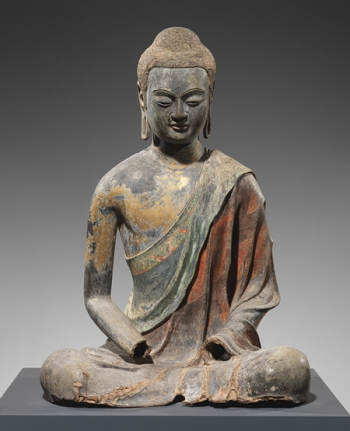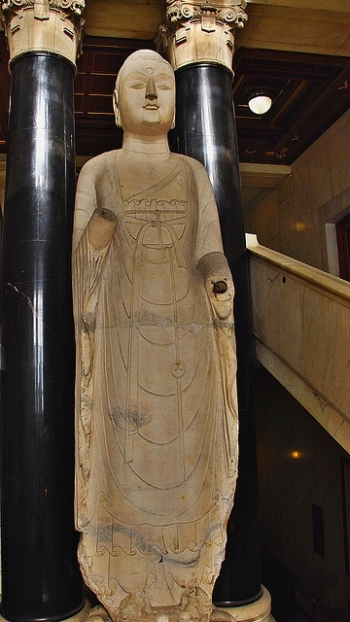 Buddha, probably Amitabha (Amituo), Tang dynasty (618–906), early 7th century China. From http://www.metmuseum.org/toah/works-of-art/19.186.
Buddha, probably Amitabha (Amituo), Tang dynasty (618–906), early 7th century China. From http://www.metmuseum.org/toah/works-of-art/19.186. The famous Sui-era Amitabha statue at the British Musuem. From www.flickr.com.
The famous Sui-era Amitabha statue at the British Musuem. From www.flickr.com.The Three Pure Land Sutras
As we know, all Buddhist teachings are spoken and expounded by Shakyamuni Buddha. Shakyamuni also introduced the Pure Land teaching, one of the eight great schools of Mahayana Buddhism. It is a teaching that can lead us to transcend the cycle of birth and death. It can also allow us to attain the state of non-retrogression, Most importantly, it expediently furthers the state of being one lifetime removed from Buddhahood through rebirth in Amitabha Buddha’s Land of Bliss.
Pure Land teaching extensively involves the power, wisdom and compassion of Amitabha Buddha. Particularly in China, Amitabha Buddha is well known and popular amongst Buddhists, both monastics and householders. Amitabha Buddha is the Buddha in the Land of Bliss, while Shakyamuni Buddha is the Buddha of our world – the Land of Saha. The former is called the Pure Land, compared with our world, which is called the Defiled Land. Both Buddhas and their lands are different by nature.
Shakyamuni Buddha, the historical Buddha of our world, introduced Amitabha Buddha in over two hundred sutras that he spoke approximately 2500 years ago. However, there are only three sutras that solely talk about Amitabha Buddha and his Pure Land. These three sutras are, namely, the Infinite Life Sutra, the Contemplation Sutra and the Amitabha Sutra. In studying Pure Land teaching, these three sutras must be regarded as the primary text for standard, proper and direct reference, and all others should be considered to be secondary and supplementary.
If we mix the Pure Land teachings with the doctrines of other Mahayana schools, we may be confused and puzzled by many controversial arguments and conflicting perspectives. Master Yinguang, a great Pure Land patriarch in the Qing Dynasty, differentiated Pure Land teaching from other schools. He said, “The teaching is called ‘Common Path’ if one practices precepts, meditation and wisdom through self power, in order to cut off delusion and karmic obstruction, and to realize the ultimate truth, thus to liberate oneself from the cycle of birth and death. Alternatively, the teaching is called ‘Particular Path’ if one possesses true faith and strong aspiration, and holdfasts in Amitabha-recitation, in order to get rebirth with the aid of Buddha’s
compassionate power.” The latter is Pure Land teaching. He further reminded us: “These two teachings cannot be mixed together in studying… If we study either one, we will gain, however, if we study them together at the same time, we will lose.”
This important point was also noted by Master Shandao of the Tang Dynasty, the de facto founder of Pure Land school in China. It is the reason why Shakyamuni Buddha said, in the Amitabha Sutra, that Amitabha’s Pure Land teaching is extremely difficult to explain, and thus difficult to believe. Identifying the right sources for studying Pure Land is critical if one wishes to meet Amitabha Buddha.
Chapter on the Easy Path and Treatise on Rebirth in the Pure Land
These texts are based on the three Pure Land sutras, particularly the Fundamental Vow of Amitabha Buddha. Also known as the Primal Vow, the Fundamental Vow is the 18th Vow amongst the 48 that Amitabha has fulfilled. It promises that he will take all sentient beings that recite his name sincerely to his Pure Land when they die. Bodhisattva Nagarjuna (circa 150–250 CE), a prominent Indian patriarch in Mahayana Buddhism, called the Pure Land teaching “the Easy Path” in his Chapter on the Easy Path. “Easy” meant that anyone could practice it, gain rebirth in the Land of Bliss, and attain Buddhahood quickly.
Master Nagarjuna described the Pure Land school as simple, easy to practice, relaxing and reassuring. He used the analogy of “traveling by ship.” On board a ship, it does not matter who we are. As long as we stay on the vessel, we can travel from the sea of suffering to the shore of happiness in a relaxed, easygoing manner. To illustrate the difficulty involved in other Bodhisattva practices, Master Nagarjuna used another analogy of “traveling by land” - carrying baggage and walking step by step. Even worse, it is uncertain whether we will arrive at our destination.
Later, another great Indian patriarch Vasubandhu (circa 400 CE) wrote the Treatise on Rebirth in the Pure Land about the meditative practices in Pure Land teaching, based on the three Pure Land sutras. It describes the beings and the environment in the Land of Bliss in full details, which is totally different from our world, thus it is not easy for ordinary people to understand, comprehend and practice.
Commentary on the Treatise on Rebirth in the Pure Land, Collection on the Land of Peace and Joy
Fortunately, a remarkable Chinese patriarch called Master Tanluan (476–542 CE) wrote the Commentary on the Treatise on Rebirth in the Pure Land, which not only makes us easier to understand the Treatise on Rebirth in the Pure Land, but also created a very solid foundation for the future establishment of the Pure Land school in China. It clarifies many important theoretical controversies between the Pure Land teaching and other Mahayana schools. It therefore served as a beacon in the development of the Pure Land school.
Another relevant reference material in studying Pure Land teaching is the Collection on the Land of Peace and Joy, written by Master Daochuo (562–645 CE). He also based his work on the Fundamental Vow of Amitabha Buddha, and clearly set up two kinds of Bodhisattva teachings, Sage Path and Pure Land Path.
Master Shandao’s Five Works, Nine Fascicles
Master Shandao (613–681 CE) of the Tang Dynasty, the de facto founder of the Pure Land school in China, compiled the Pure Land teachings and wrote the Five Works in Nine Fascicles, which definitively laid down the theories and practices of the Pure Land tradition.
Master Shandao wrote his four-fascicle Commentary on the Contemplation Sutra to correct misconceptions made by other masters in his time. Before he began writing, Master Shandao made resolutions before the Buddhas, asking for inspiration. That very night, he had a sacred vision. A sagely monk appeared in his dreams every evening to instruct him about the profound meanings of the text. When his work was done, the monk disappeared.
The Commentary on the Contemplation Sutra is a definitive commentary for the ages, and Master Shandao was called “the master who defined [the Contemplation Sutra] for all time.” It is sometimes said to be the ‘sutra spoken by Amitabha Buddha.’
The other four works written by Master Shandao are In Praise of Dharma Practices (2 fascicles), In Praise of the Rite of Rebirth (1 fascicle), In Praise of Pratyutpanna (1 fascicle) and Dharma School of Contemplation and Recitation (1 fascicle).
Pure Land teaching is easy to practice, but difficult to understand and believe. Thus, it is of utmost importance to identify the proper source. This tradition originated from the Fundamental Vow of Amitabha Buddha. In addition, it is crucial to follow the interpretations and instructions of the Pure Land patriarchs from the same lineage for studying Pure Land Buddhism. “Teachings of Amitabha Buddha” is an inspiring column about the vital spiritual matters of Pure Land Buddhism – from its history, philosophy, and practice to its scriptures and their exegesis and interpretation. The column is penned by Alan Kwan, the founding editor of Buddhistdoor.com. 















